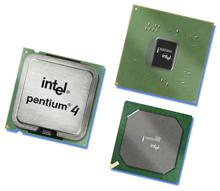Pentium 4 Extreme Edition 3.46GHz 1066MHz FSB
Introduction
 The folks out in Sunnyvale have been releasing new additions to their Athlon 64 processor lineup with the kind of fevered pace we've come to expect from major-league semiconductor manufacturers. So too has the ever-dominant Intel. With 78,000 employees worldwide and almost 10 times the revenue of its nearest competitor at $30 billion annually, its this kind of critical mass that allows a company to pour endless resources into a program and drive higher reaching product line goals.
The folks out in Sunnyvale have been releasing new additions to their Athlon 64 processor lineup with the kind of fevered pace we've come to expect from major-league semiconductor manufacturers. So too has the ever-dominant Intel. With 78,000 employees worldwide and almost 10 times the revenue of its nearest competitor at $30 billion annually, its this kind of critical mass that allows a company to pour endless resources into a program and drive higher reaching product line goals.
Earlier this month, we brought you a view of AMD's new Athlon FX-55 and Athlon 64 4000+ processors and their relative performance versus Intel's flagship CPUs. Today we've got Intel's latest weapon locked and loaded into its "Enthusiast Class" silo. The Pentium 4 Extreme Edition 3.46GHz with 1066MHz FSB is on our test bench here at HotHardware. Intel had to further validate the 925X chipset for this higher system bus speed this time around as well, so we're also looking at the release of the kicker chipset enhancement on this launch, dubbed the i925XE. We'll dig in and crank it all up for you in the pages ahead.

Intel Pentium 4 In LGA Packaging And i925X Chipset
|
Architecturally, not a thing has changed for the Pentium 4 Extreme Edition, with the exception of its multiplier ratio. The only significant change with this Intel CPU is that Intel validated it with a lower bus multiplier along with a significantly higher frontside bus at 1066MHz, versus the previous 800MHz system bus. In fact, enthusiast overclockers have probably already seen some of the benefits of higher frontside bus speeds, while taking multiplier-locked retail chips to their outer limits. Also note that this new chip has a higher TPD (Thermal Power Dissipation) number at 110 Watts versus a standard P4 EE 3.4GHz chip at 89 Watts.
The other notable is that this CPU is being targeted strictly for Intel's new i925XE chipset, which is essentially identical to the previous i925X, only it too has been validated for the new 1066MHz FSB. Motherboard manufacturers no doubt will likely migrate to this new chipset for their Alderwood (i925)-based offerings moving forward. We should also mention that most likely motherboard partners will not be able to just release a BIOS revision that will enable 1066MHz FSB operation without an associated board level hardware revision, as well. This short-term limitation is most likely due to a new system clock PLL divide ratio that needs to be accommodated in the new design for support of 1066MHz FSB. Regardless, if you took the plunge into the i925X, we're sure you'll be more than disappointed that in fact you'll need an entirely new motherboard to support the next generation P4 FSB.








